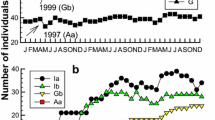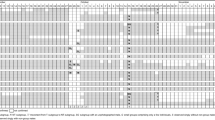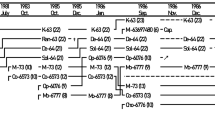Abstract
We studied the dynamics of a group of Barbary macaques (Macaca sylvanus) in Algeria from March 1983 to November 1989. Troop fission began in autumn 1987, when group size had more than doubled, to include 76 animals. We observed 11 temporary splits of this group during the mating seasons of 1987 and 1988. The process was interrupted during the 1988 birth season. In June 1989, fission resumed and ended with the formation of three independent groups that included 50, 24, and 13 individuals. Adult females played an important role in the process of fission. They initiated the rapid formation of two, and later three, coherent nuclei, distributed in two or three bisexual subgroups; on several occasions these nuclei also formed subgroups without any adult males. Adult males remained together in a single nucleus for longer periods of time than females did. However, during fission, 35% (N=20) of resident males emigrated to neighboring groups, while 11 strange males immigrated into the focal group; over 6 years, 57% of the male transfers occurred after the beginning of the process. After group fission, maternally related individuals lived together in the new groups. The majority of resident males remained with the largest of the three groups, while most of the immigrant males were in another group. The third group included a single adult male. Possible factors that induce group fission are discussed.
Similar content being viewed by others
References
Chepko-Sade, B. D., and Sade, D. S. (1979). Patterns of group spliting within matrilineal kinship groups, a study of social group structure inMacaca mulatta.Behav. Ecol. Sociobiol. 5: 67–86.
Cheverud, J. M., and Dow, M. M. (1985). An autocorrelation analysis of genetic variation due to linear, fission in social groups of rhesus macaques.Am. J. Phys. Anthropol. 67: 113–121.
Cords, M., and Rowell, T. E. (1986). Group fission in blue monkeys of the Kakamega forest, Kenya.Folia Primatol. 46: 70–82.
Deag, J. M. (1974).A Study of the Social Behavior and Ecology of the Wild Barbary Macaques Macaca sylvanusL., Unpublished Ph.D. thesis, University of Bristol., Bristol.
Dittus, W. P. J. (1988) Group fission among wild toque macaques as a consequence of female resource competition and environmental stress.Anim. Behav. 36: 1626–1645.
Dunbar, R. I. M., and Dunbar, E. P. (1974). Ecology and population dynamics ofColobus guereza in Ethiopia.Folia Primatol 21: 188–208.
Fa, J. E., Taub, D. M., Ménard, N. and Stewart, P. J. (1984). The distribution and current status of the Barbary macaque in North Africa. In Fa, J. E. (ed.),The Barbary Macaque: A Case Study in Conservation, Plenum Press, New York and London, pp. 79–111.
Furuya, Y. (1968). On the fission of troops of Japanese monkeys II Five fissions and social changes between 1955 and 1966 in the Gayusan troop.Primates 9: 323–350.
Furuya, Y. (1969). On the fission of troops of Japanese monkeys II. General view of troop fission of japanese monkeys.Primates 10: 47–69.
Koyama, N. (1970). Changes in dominance rank and division of a wild japanese monkey troop in Arashiyama.Primates 11: 335–390.
Maruhashi, T. (1982). An ecological study of troop fissions of japanese monkeys (Macaca fuscata yakui) on Yakushima Island, Japan.Primates 23: 317–337.
Mehlman, P. T. (1985). Intergroup dynamics of the Barbary macaque (Macaca sylvanus L.) Ghomaran Rif Mountains Morocco.Am. J. Phys. Anthropol. 66: 204.
Melnick, D. J., and Kidd, K. K. (1983). The genetic consequences of social group fission in a wild population of rhesus monkeys (Macaca mulatta).Behav. Ecol. Sociobiol. 12: 229–236.
Ménard, N., and Vallet, D. (1986). Le régime alimentaire deMacaca sylvanus dans différents habitats d'Algérie, II. Régime en forêt sempervirente et sur les sommets rocheux.Rev. Ecol. (Terre Vie) 41: 73–192.
Ménard, N., and Vallet, D. (1988). Disponibilités et utilisation des ressources par le magot (Macaca sylvanus) das différents milieux en Algérie.Rev. Ecol. (Terre Vie) 43: 201–250.
Ménard, N., Vallet, D., and Gautier-Hion, A. (1985). Démographie et reproduction deMacaca sylvanus dans différents habitats en Algérie.Folia Primatol. 44: 65–81.
Missakian, E. A. (1973). The timing of fission among free-ranging rhesus monkeys.Am. J. Phys. Anthropol. 36: 621–624.
Nash, L. T. (1976). Troop fission in free-ranging baboons in the Gombe Stream National Park, Tanzania.Am. J. Phys Anthropol. 44: 63–78.
Oi, T. (1988). Sociological study on the troop fission of wild japanese monkeys (Macaca fuscata yakui) on Yakushima island.Primates 29: 1–19.
Paul, A., and Kuester, J. (1988). Life-history patterns of Barbary macaques (Macaca sylvanus) at Affenberg Salem. In Fa, J. E., and Southwick, C. H. (eds.),Ecology and Behavior of Food-Enhanced Primate Groups, Alan R. Liss, New York, pp. 199–228.
Southwick, C. H., Beg, M. A., and Siddiqi, M. R. (1965). Rhesus monkeys in North India. In DeVore, I. (ed.),Primate Behavior, Field Studies of Monkeys and, Apes, Holt, Rinehart and Winston, New York, pp. 111–159.
Struhsaker, T. T., and Leland, L. (1988). Group fission in red-tail monkeys (Cercopithecus ascanius) in the Kibale forest, Uganda. In Gautier-Hion, A., Bourlière, F., Gautier, J. P., and Kingdom, J. (eds.),A Primate Radiation, Evolutonary Biology of the African Guenons, Cambridge University Press, Cambridge, pp. 364–388.
Sugiyama, Y. (1960). On the division of a natural troop of japanese monkeys Takashiyama.Primates 2: 109–148.
Taub, D. M. (1977). Geographic distribution and habitat diversity of the Barbary macaqueM. sylvanus L.Folia Primatol. 27: 108–133.
Yamagiwa, J. (1985). Socio-sexual factors of troop in wild japanese monkeys (Macaca fuscata yakui) on Yakushima island, Japan.Primates 26: 105–120.
Author information
Authors and Affiliations
Rights and permissions
About this article
Cite this article
Ménard, N., Vallet, D. Dynamics of fission in a wild Barbary macaque group (Macaca sylvanus). International Journal of Primatology 14, 479–500 (1993). https://doi.org/10.1007/BF02192778
Received:
Accepted:
Issue Date:
DOI: https://doi.org/10.1007/BF02192778




